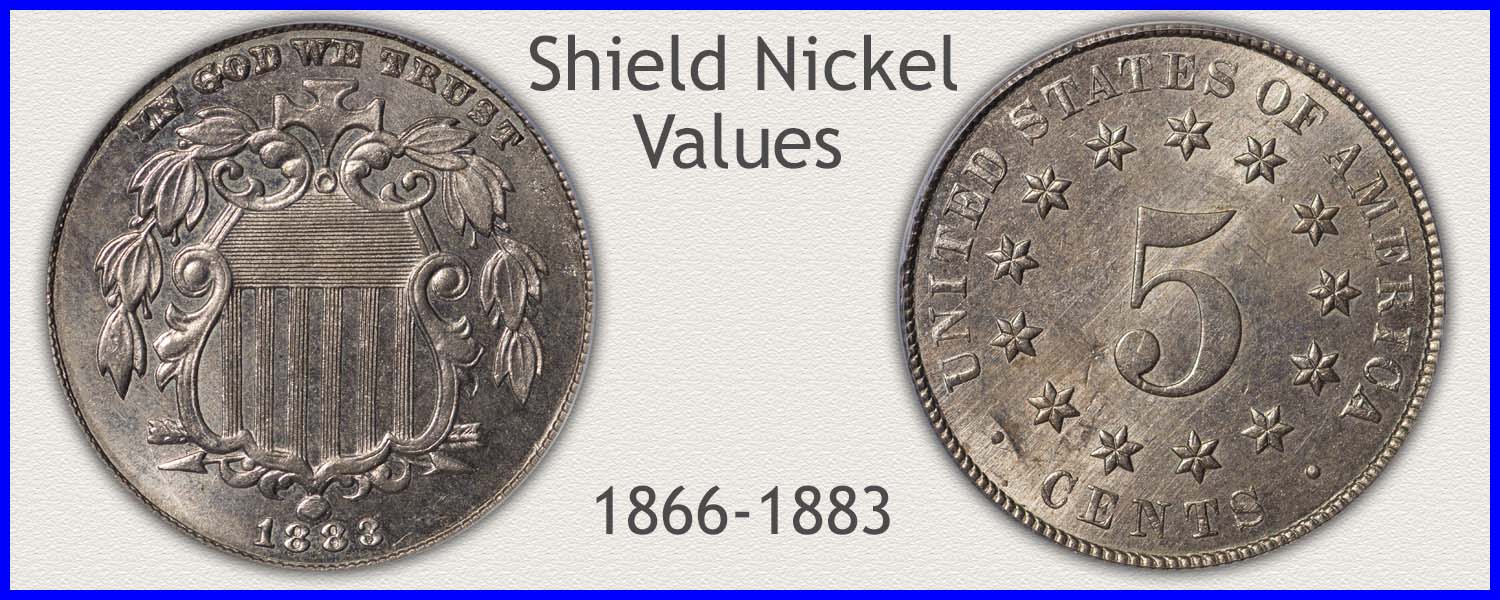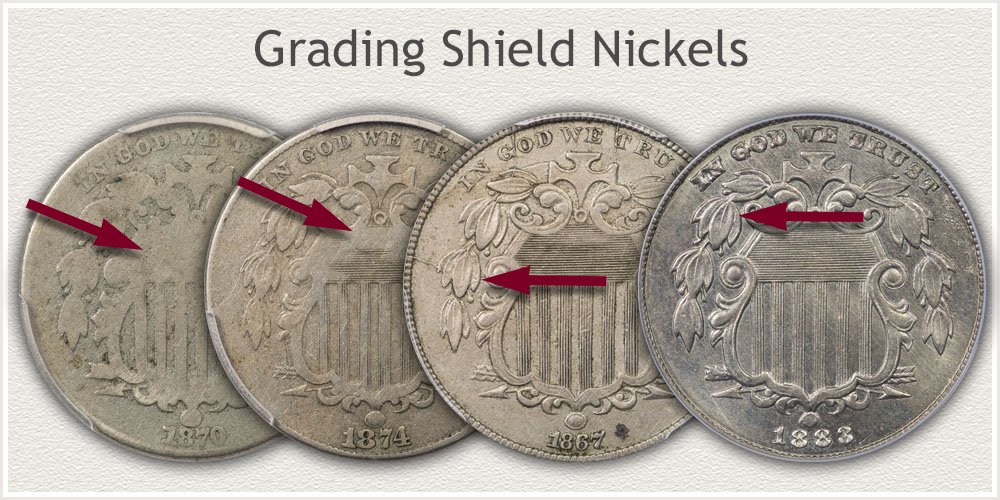Coin Values Moving with Precious Metals: Up-Dated 12/1/2025: Gold $4236 | Silver $56.79
1870 Nickel Value
1870 nickel value begins to show a rise in premiums because of a drop in production. Here is a coin difficult to find in pleasing condition. Overall, it is a scarce issue. This elusive quality leads to quick acceptance within the market for nice examples.
Using a step-by-step approach defines features determining the true quality of a coin. Accuracy of the date, begins the description, followed by judging its condition. Reference the images as you move through the process. Close matches of your coin quickly confirm its place on the value chart.
Begin with a review of the chart, listing a range of how much an 1870 nickel is worth. There is a significant increase in value across the entire condition range.
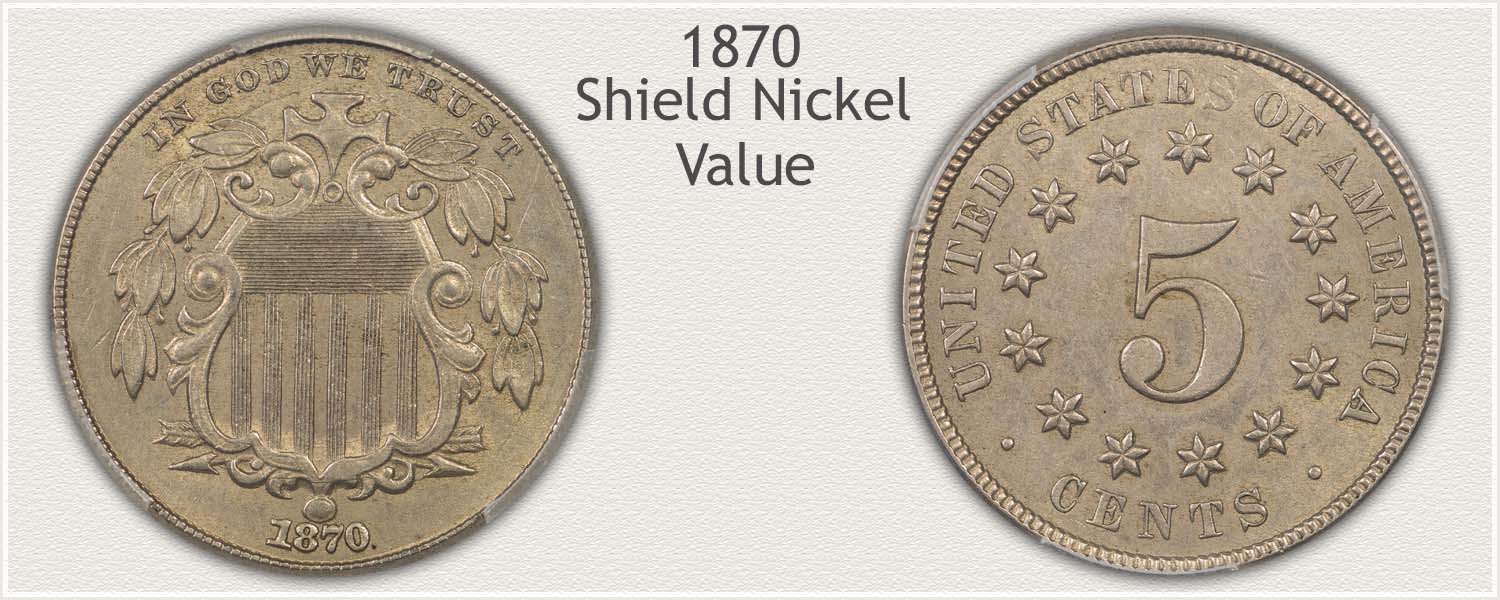
Steps Leading to Value:
- Step 1: Date Identified - Start with confirming the date, recognizing the underlying scarcity of this 1870 nickel.
- Step 2: Grading Condition - Identifying the condition of coins is an important part of an accurate description. Different grades of coins determine market acceptance and premiums.
- Step 3: Special Qualities - Complete the coin's description by identifying the qualities that collectors consider pleasing.
| 1870 Nickel Value | ||||
|---|---|---|---|---|
| Condition of Coin | ||||
| Date | Good | Fine | Extremely Fine |
Mint State |
| 1870 Nickel Value Updated | 2025 | |||
| 1870 | $26 | $48 | $76 | $157 |
The above chart lists wholesale coin values. Computed from auction records, dealer's listings with various markup factors figured in. Variations in value occur subject to subtle grading points, and dealer needs.
Step 1: 1870 Begins the Scarce Years of the Shield Series
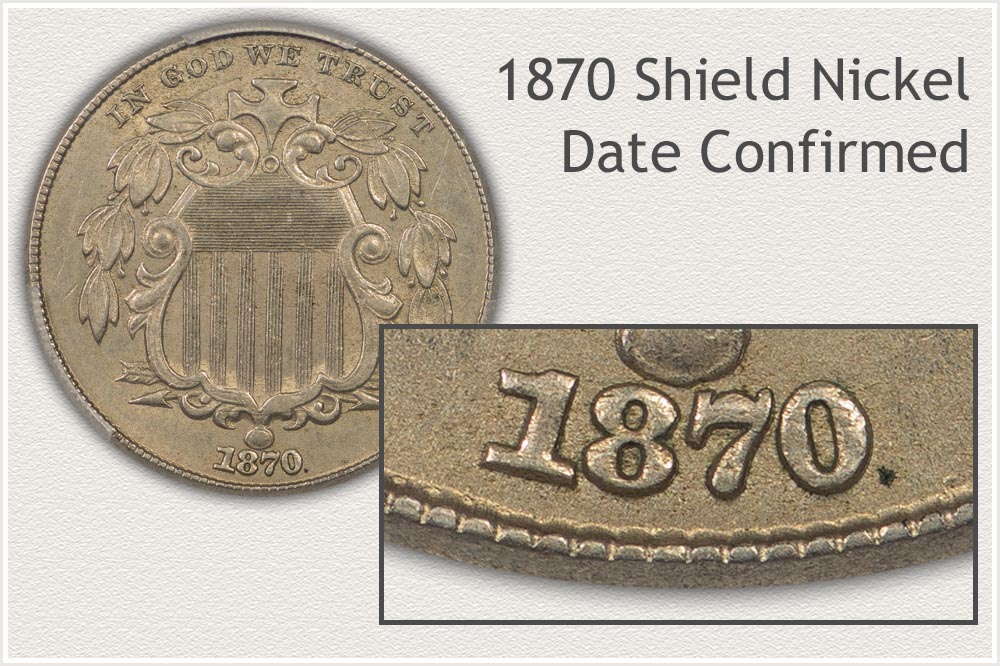
1870 Shield nickels enjoy premium values within the series. Numbers produced lowered to 4.8 million nickels released into circulation. Philadelphia was the only mint striking nickels at the time. The mint focused its attention on producing larger denominations.
Nice, lightly circulated, or higher quality pieces enjoy steady demand from collectors. An 1870 nickel also represents a somewhat scarce coin appealing to new collectors. A pleasing example offered within the coin market quickly finds a home in a collection.
The actual size of the date chosen for the series is small. Often difficult to read accurately. Using magnification helps identify each numeral. All coins are collected by their specific date. Confirming the date is an important part of their complete description. After recording the date, condition becomes the next strong factor when determining its value.
Step 2: | Judge the Grade Using Images and Descriptions
How to Recognize a Scarce Condition 1870 Shield Nickel
Grades assigned to coins are hobby terms used when describing their condition. Determining the grade of a Shield nickels narrows their value range. Value charts list the different grades, with higher premiums indicating their scarcity.
When judging condition, a successful approach verifies specific details remain visible. On Shield nickels, design elements within the shield provide many features to evaluate. Removal of metal due to wear displays as distinct patterns on the shield's intricate detail.
Images of standard grades show the amount of detail required to meet the grade. Comparing the condition of your coin with these images finds a close match. Looking closely at the surface, follow the descriptions identifying details for each grade. An 1870 nickel with ample detail and pleasing eye appeal is a scarce coin.
Mint State Grade
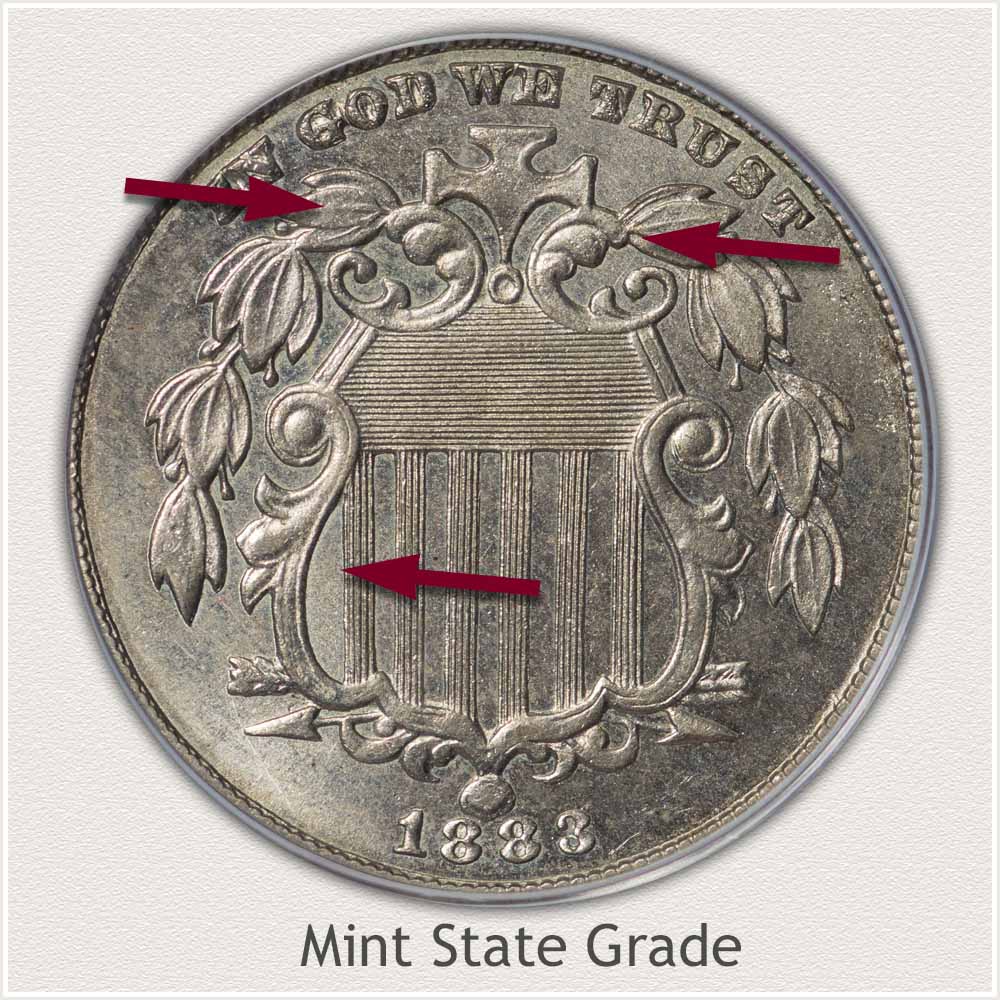
Mint State: Mint State is the grading term used by coin collectors and the market. It describes a coin without wear on its surface. A Shield Nickel in Mint State condition remains with full details, and no flattening or smoothing of the design. Grading defines a coin's condition, helping establish its value and desirability to collectors.
Note the luster and shine of the example. The immense pressure of striking a coin causes the metal to "flow" into the die's recesses. This process imparts a fine grain texture to the surface. Luster results from light reflecting off this original surface. Luster is consistent across the high curves of the shield and the flat field of the coin. Any breaks or interruptions in this uniform texture indicates wear.
When judging condition, focus on the well-struck areas of the design. The example image shows a nickel with excellent detail on the shield border. At the top of the shield, look closely at the curved elements of the frame. These are high, rounded contours with deep recessed areas.
Wear on a coin displays smooth, flattened spots on raised contours. Additionally, a worn surface loses its texture, altering the way the metal reflects light. Color of the metal takes on a grayish tone, with a polished appearance.
Tilt your coin under a single light source. Luster remains unbroken as the light plays across the surface. Compare the surface texture and luster of both high and low reliefs. Look for a similar shine from each, confirming a Mint State nickel.
Extremely Fine Grade
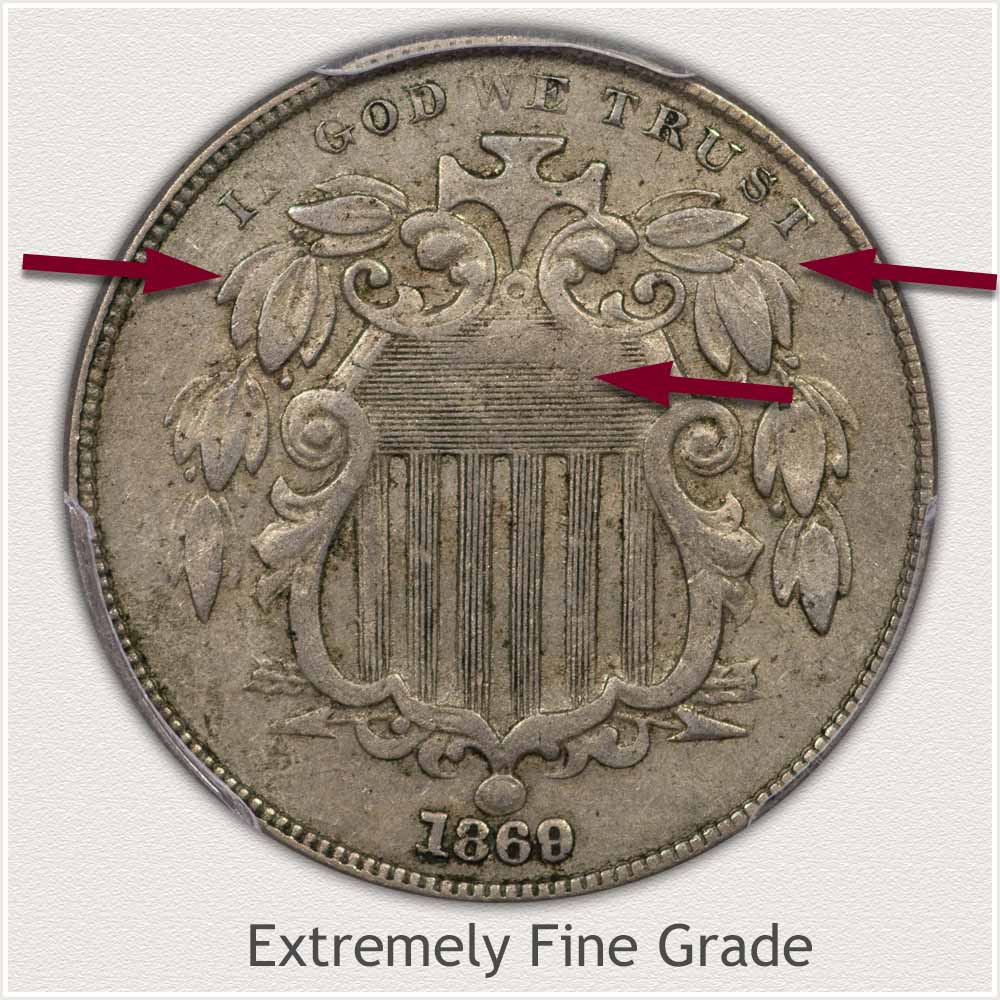
Extremely Fine: Light wear, only on high relief points, describes a Shield nickel in Extremely Fine grade. As you examine your coin, judge the vertical and horizontal lines within the shield. At this grade level, they draw the eye because of their crisp, well-defined appearance. Compared to the example image, a close match identifies above average condition. Inspection of a second area, the leaves to the sides, further narrows and confirms the grade.
At the Extremely Fine grade level, each leaf within both side branches is complete. Edges defining the leaves are visible and bold. A full separation of the leaves is a standard measurement to meet the grade quality. This quality is well represented on the left side of the illustrated coin. Light wear smooths the very ends of the leaves, causing a slight flatness. Inner veins remain within a lower contour that rises to a defined edge. The key grading metric is wear confined to leaf ends. Full contours within the leaves, and complete leaf edges, further refines the standard. Look for these features on your coin.
Judge a subtle observation when grading. Often, the leaves on one side appear with more detail than the other. The example coin illustrates this point on the right-side branch. An uneven strike when minted caused the difference in sharpness of detail. Reference the bolder, left-side first, giving an accurate measurement of wear. Next, examine the less sharp side right-side. Although with fewer inner details, all leaf edges must remain well defined. In total, fine lines within the shield and detailed leaves are areas deciding the grade.
Fine Grade
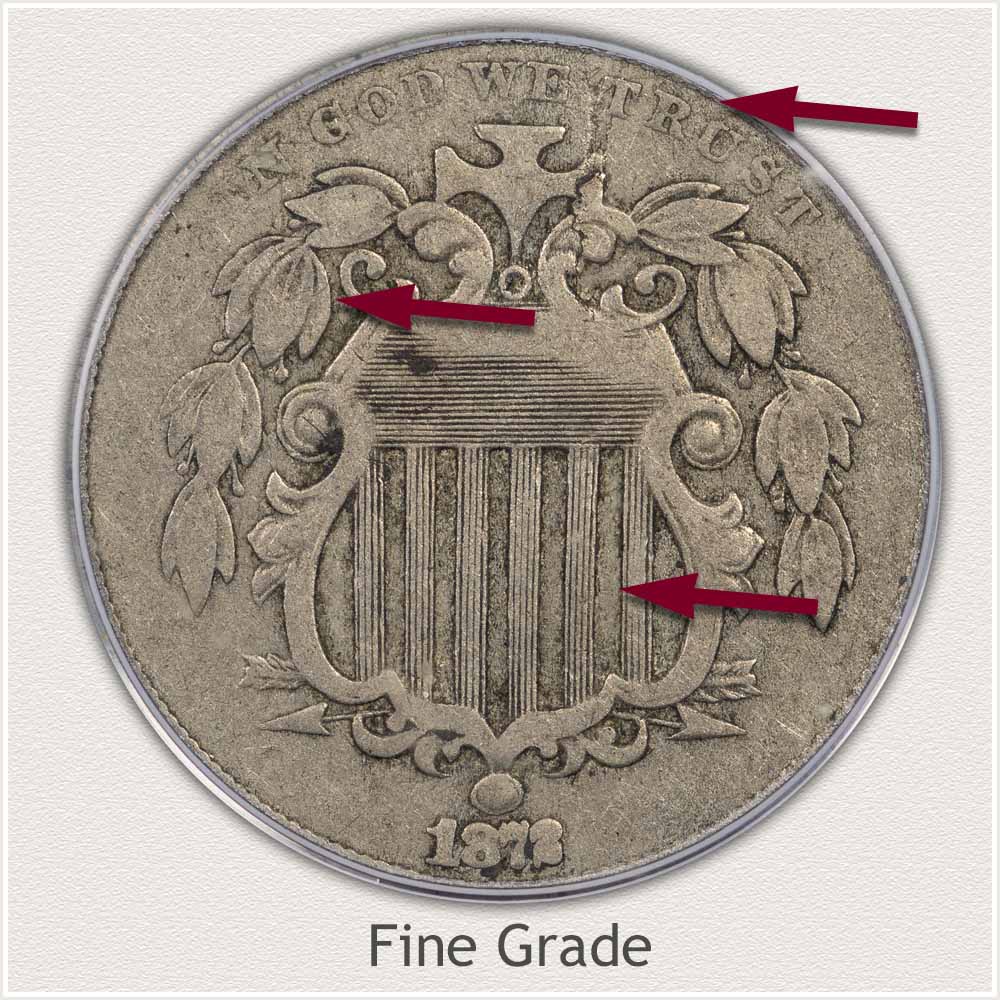
Fine Grade: Nice detail remains on a Shield nickel in Fine grade. Visible detail and moderate wear give these coins a slightly flattened appearance. Using specific standards helps recognize the amount of detail required for the grade. Inspecting design elements of the shield and leaves judge the amount of wear to the surface.
First concern is a readable motto and date. The coin illustrated is a professionally evaluated Shield nickel in Fine grade. The motto "In God We Trust" passes the grade standard, notice it is slightly faded in some areas. Importantly, the date is recognizable. It is also somewhat indistinct.
Inspecting the leaves, most have a slight high and low contour. Many still show the central vein element, a nice detail. Meeting the grade, edges defining the leaves are very bold. Only in limited areas are edges of the top leaves merged with the leaves below. At this time, closely compare your coin to the image. Verify your coin matches the amount of leaf detail.
Next use the vertical and horizontal lines in the shield to gauge wear. The example coin displays many complete horizontal lines. With at least half the horizontal lines showing, it is well within the grade range. This coin also meets the grade with most vertical lines complete. A few merged areas within the vertical lines are allowable.
Crisp details, clearly visible, describe the Fine condition nickel. Some minor details worn smooth next to bold lines is a collectible quality coin.
Good Grade
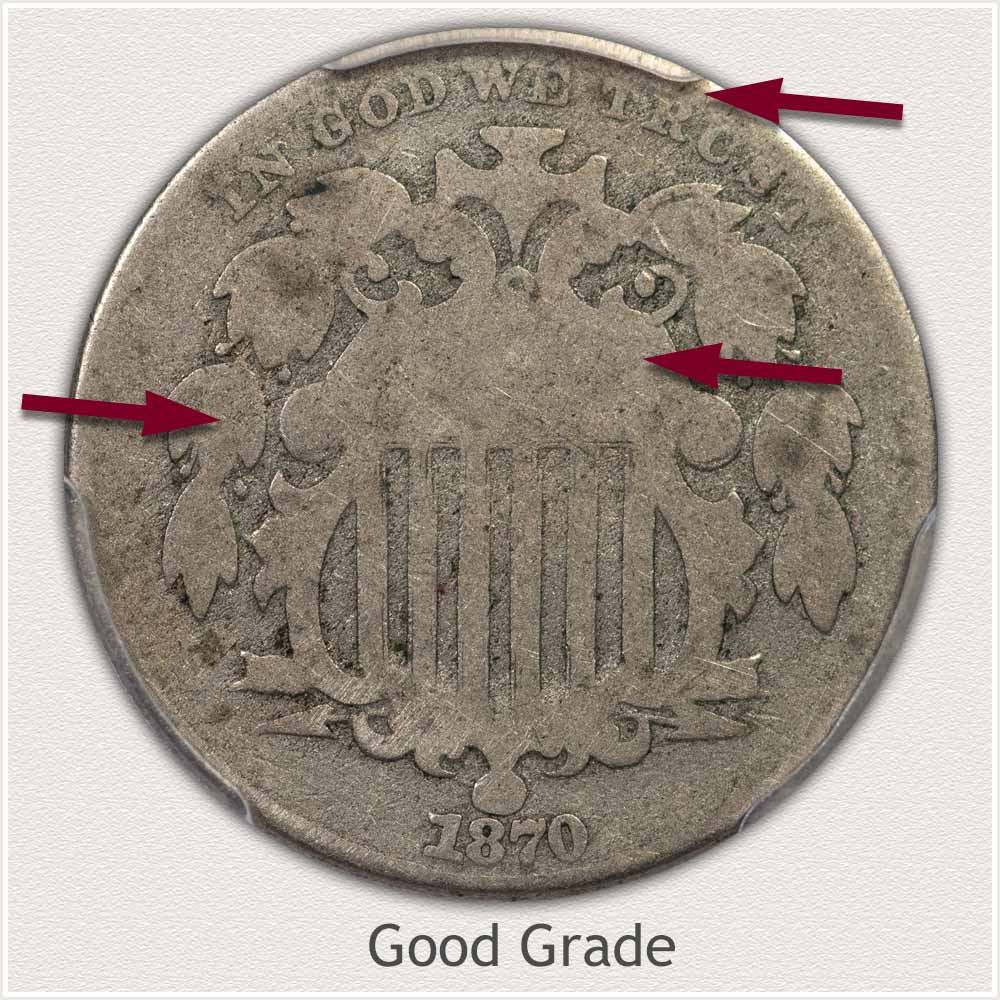
Good Grade: A number one standout impression of a Good grade 1870 nickel is the well-worn design. Heavy wear smooths major features. Because of this wear, only the outer edges of elements rise from the field of the coin. This definition of the grade also includes strict qualities remain visible. A readable date, and most of the motto "In God We Trust" is legible. These two are particularly important to keep the coin at grade level.
In a close inspection, wear flattens the central area of the shield and continues outward. The shield and frame are smooth. On either side, the leaves are without any inner detail. Importantly, the central shield, the frame, or leaves do not blend with the field. Moving upward, the Motto remains very clear, an added plus to eye appeal. Also, the date is clear, another plus. At the very edges of the coin, missing areas of the rim are acceptable for the grade. On the example illustrated, looking to the left of the date, parts of the rim remain raised.
A scarcity of Shield nickels shows in strong premiums for all grades of preservation. Today, most 1870 nickels are in a state of heavy wear. It takes a coin with eye appeal offsetting the amount of wear to attract collectors. Keeping this in mind when viewing your coin helps to place an accurate grade on the piece.
How to Video: Grading Shield Nickels
Step 3: | Special Qualities | Identify Highly Collectible Nickels
Eye Appeal and Solid Value Shield Nickels
Eye appeal of a Shield nickel is often a deciding factor with collectors. It influences their decision when they consider adding the coin to a collection. These aesthetics are sometimes very obvious; a very dark coin is unappealing. Large nicks on the surface interrupt the eye. Subtle qualities are also evaluated; slight discoloration, a small scratch, or just one to many nicks.
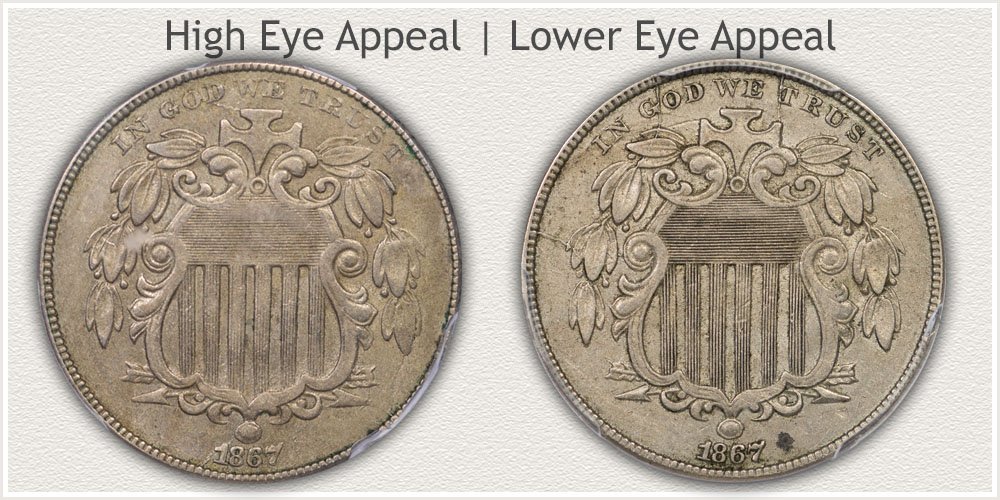 Comparing High and Low Eye Appeal of Shield Nickels
Comparing High and Low Eye Appeal of Shield Nickels
The two coins imaged show similar amounts of wear. Light wear slightly smooths only the highest relief points. Both coins are professionally graded as Extremely Fine. Considered a premium condition in the Shield nickel series. Importantly, a small differences in eye appeal does separate one coin from the other. Notice the small, dark spot near the date on the coin to the right. This small discoloration is often a deciding factor in passing on the coin in favor of the left side coin.
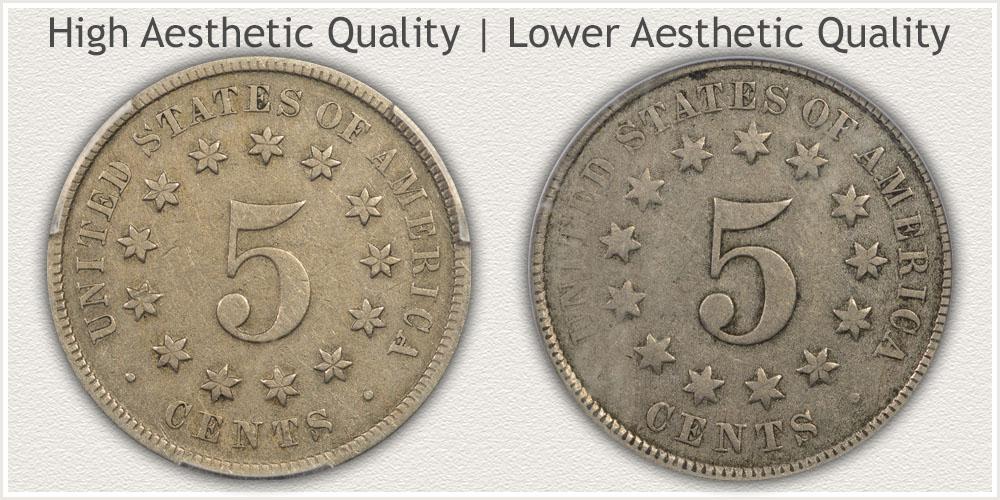 Aesthetic Qualities are Compared Between Two Shield Nickels
Aesthetic Qualities are Compared Between Two Shield Nickels
The above image shows the reverse of two circulated Shield nickels. Wear has smoothed the surface to the extent; both are within the Fine grade. Taking a moment to view and compare each, the left-hand coin stands out as crisp. On the right-hand coin, faded letters of UNITED catch the eye. This area of the legend was weakly struck and gives an off-balance look to the coin. Eye appeal of the left-hand coin is in its favor. The coin market awards a solid value to these eye appealing coins.
All conditions of Shield nickels are evaluated based on their overall appearance. Each collector finds coins of their preference when building collections. Inspect for any distractions, and identify the special quality coin.
References
U.S. Mint. 1888 U.S. Mint Annual Report
https://nnp.wustl.edu/library/book/313
U.S. Mint. Catalogue of Coins of the United States
https://nnp.wustl.edu/library/book/554591
Coin Values | CoinStudy Articles
Date by Date
In Depth Shield Nickel Value
Shield Nickel Value | Complete Value Chart of All Years
Complete value chart listing of Shield Nickels. Note how much an 1870 is worth in high condition compared to other dates. The important step of judging condition is further illustrated with large grading images. This approach provides a step-by-step method to an accurate reading the chart.
How to Grade Shield Nickels | Visual Guide
When viewing the visual guide, examine various levels of wear and how they determine a grade. The grading descriptions with video and images indicate major points of the coin design. A close inspection of these features evaluates the condition of a Shield Nickel.
Coin Value Guide | How to Value a Coin Collection
Old coin collections are routinely valued to keep up with their latest worth. Premiums awarded to coins change yearly. Changes either show an up-ward increase or steadily holding strong. Follow the defined process outlined to identify the series of coin. Next, identify its date and mint variety, and then judge its condition. This step-by-step approach focuses on key features helping narrow a current value.
Print (Printable) the Coin Values Worksheet
An organized listing of Shield Nickels assures a complete description of each coin. Key details of the date and mint variety are entered. Condition, a very important detail is recorded. Any special qualities identified also help define the coin. Enter current values to keep a written record.
Safe Coin Storage | Recommendations
Properly storing coins long term avoids unnecessary damage. Supplies designed specifically for the coin hobby protect coins and organize a collection. Today, modern, inert plastic holders house individual to many coins. A few basic supplies safely protect coins from damage and limit environmental exposure.
★Coin Values Discovery finds 1870 Nickel Value and...
Old U.S. coin values. Referencing images, correctly identify the different coin series, a key first step. Proceed with additional steps, recognizing date and mint combinations. Next, judge the condition of the coin by referencing images. This defined method leads to an accurate evaluation of how much a box of old coins is worth.
